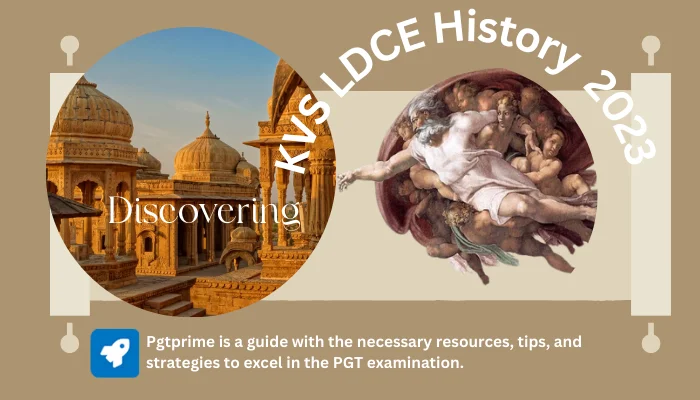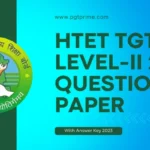👉FROM (Q.21-To-Q.40)
21. Who among the following propounded that there is a close similarity between the European and Sanskrit languages?
- William Jones
- Max Muller
- V.A. Smith
- Karl Marx
Answer: KVS LDCE History Question Paper and Answers PDF 2023
(1) William Jones
The person who propounded that there is a close similarity between the European and Sanskrit languages is William Jones. Sir William Jones (1746-1794) was a prominent British philologist, Orientalist, and jurist. He is best known for his significant contributions to the study of ancient Indian languages and his role in establishing the field of Indo-European studies.
22. The river Jhelum was known in the Vedic period by the following name:
- Vitasta
- Askini
- Parusni
- Sutudri
Answer: KVS LDCE History Question Paper and Answers PDF 2023
(1) Vitasta
The river Jhelum was known in the Vedic period by the name “Vitasta”.
23. The Jaina tirthankara Parsvanatha was intimately connected with which of the following towns?
- Champa
- Dhauli
- Kashi
- Vaisali
Answer: KVS LDCE History Question Paper and Answers PDF 2023
(3) Kashi
The town of Varanasi, also known as Kashi, According to Jain tradition, Parsvanatha attained enlightenment and achieved moksha (liberation) in Varanasi.
24. Who among the following rulers adopted the title of ‘Varman’for the first time?
- The rulers of Kamarupa
- The rulers of Bengal
- The rulers of Orissa (Odisha)
- The rulers of Karnataka
Answer: KVS LDCE History Question Paper and Answers PDF 2023
(1) The rulers of Kamarupa
The rulers of Kamarupa adopted the title of ‘Varman’ for the first time. Kamarupa, located in present-day Assam in northeastern India, was an ancient kingdom that existed from the 4th century to the 17th century.
25. Which of the following periods is known as the second historical period in the context of the region south of the Vindhyas?
- 100 – 200 BCE
- 200 – 300 CE
- 300 – 700 CE
- 800 – 1000 CE
Answer: KVS LDCE History Question Paper and Answers PDF 2023
(3) 300 – 700 CE
26. Who among the following were the immediate successors of the Satavahanas?
- Chalukyas
- Rashtrakutas
- Vakatakas
- Kadambas
Answer: KVS LDCE History Question Paper and Answers PDF 2023
(3) Vakatakas
The Vakataka dynasty emerged in the Deccan region of India after the decline of the Satavahanas. They ruled from the 3rd to the 5th century CE. The Vakatakas played a significant role in the history of South India and their kingdom included parts of present-day Maharashtra, Madhya Pradesh, and Andhra Pradesh.
27. Which of the following regions was known as Vengi?
- The doab of Godavari and Krishna
- The doab of Krishna and Kaveri
- The doab of Narmada and Tapti
- The doab of Kaveri and Tungabhadra
Answer: KVS LDCE History Question Paper and Answers PDF 2023
(1) The doab of Godavari and Krishna
Vengi, also known as Vengi Kingdom or Vengi Rajya, was a historical region located in the southeastern part of India. It was situated in the doab, or the fertile land between the Godavari and Krishna rivers. Vengi played a significant role in the political and cultural history of South India.
28. ‘Ur ’ was a kind of residential unit in the form of a village. Villages were primarily inhabited by:
- Teachers
- Peasants
- Artisans
- Traders
Answer: KVS LDCE History Question Paper and Answers PDF 2023
(2) Peasants
Peasants constituted the majority of the village population as they were directly involved in agricultural activities and were responsible for producing food and sustaining the village economy.
29. Which among the following was not a part of Ashoka’s administrative policy?
- To integrate different religious sects
- Tolerant religious policy
- Grants to all religions
- Propagation of Buddhist religion
Answer: KVS LDCE History Question Paper and Answers PDF 2023
(4) Propagation of Buddhist religion
Although Ashoka embraced Buddhism and worked towards its promotion, he also supported other faiths.
30. Who among the following adpoted the title of Maharajadhiraja for the first time?
- Satavahan rulers
- Kushana rulers
- Gupta rulers
- Chalukya rulers
Answer: KVS LDCE History Question Paper and Answers PDF 2023
(2) Kushana rulers
The Kushan Empire, which existed from the 1st to the 3rd century CE in Central Asia and Northern India, saw the adoption of the title Maharajadhiraja by its rulers. Kushan rulers like Kanishka and his successors assumed the title of Maharajadhiraja.
31. Who among the following adopted the title of Devaputra for the first time?
- Magadha rulers
- Kushana rulers
- Gupta rulers
- Vakataka rulers
Answer: KVS LDCE History Question Paper and Answers PDF 2023
(2) Kushana rulers
The title of “Devaputra,” means “son of God” or “divine prince.” The Kushana rulers were known for their patronage of various religions, including Buddhism and Hinduism, and their adoption of the title “Devaputra” further enhanced their religious and political legitimacy.
32. Who among the following introduced in India horse saddle for the first time?
- Mauryas
- Shunga
- Kushanas
- Guptas
Answer: KVS LDCE History Question Paper and Answers PDF 2023
(3) Kushanas
The Kushanas, who were of Central Asian origin, brought with them advanced cavalry techniques and equipment, including the horse saddle. Their introduction of the horse saddle significantly impacted military tactics and warfare in ancient India.
33. Which of the following was known as yavan priya in Sanskrit language for its liking among the Indo-Greeks?
- Cloves
- Cardamom
- Pepper
- Cinnamon
Answer: KVS LDCE History Question Paper and Answers PDF 2023
(3) Pepper
The spice known as “Yavan Priya” in Sanskrit language for its liking among the Indo-Greeks is Pepper. Pepper, specifically black pepper, was highly valued for its distinctive flavor and aroma. Pepper was an important commodity among the Indo-Greeks which is well-documented in historical texts.
34. Which of the following semi-precious stones was exported from Ujjaiyani during 200 BCE to 300 CE?
- Chert
- Turquoise
- Topaz
- Carnelian
Answer: KVS LDCE History Question Paper and Answers PDF 2023
(4) Carnelian
Ujjaini, an ancient city in present-day Madhya Pradesh, India, was known for its production and trade of various goods, including semi-precious stones. Carnelian, a reddish-brown variety of chalcedony, was one of the stones that were exported from Ujjaini during that period.
35. Who among the following discovered blue colour?
- Chinese
- Indians
- Arabs
- Europeans
Answer: KVS LDCE History Question Paper and Answers PDF 2023
(2) Indians
The use of indigo as a dye can be traced back to ancient civilizations in various parts of the world, including India, Egypt, and Mesopotamia. It was commonly extracted from plants, such as Indigofera tinctoria, and used to produce a rich blue color.
36. In which of the following texts the first ever reference to medicines is mentioned?
- Sushrut Samhita
- Charak Samhita
- Samveda
- Atharvaveda
Answer: KVS LDCE History Question Paper and Answers PDF 2023
(4) Atharvaveda
The Atharvaveda, one of the four Vedas of ancient Indian literature, contains hymns and verses related to various aspects of life, including healing, diseases, and herbal remedies.
37. The beginning of cave temples is associated with which of the following centuries?
- Second century
- Fourth century
- Fifth century
- Seventh Century
Answer: KVS LDCE History Question Paper and Answers PDF 2023
(1) Second century
The beginning of cave temples in India is associated with the second century. Ajanta and Karle were constructed in the second century.
38. Which of the following raw material was not imported by the Mesopotamian people?
- Gold
- Poplar wood
- Silver
- Copper
Answer: KVS LDCE History Question Paper and Answers PDF 2023
(2) Poplar wood
The Mesopotamians had access to abundant natural resources such as gold, silver, and copper within their own region. However, poplar wood, which is a type of hardwood, was readily available in the region and did not need to be imported.
39. What are the Mesopotemian Ziggurats?
- The Assembly Hall of Sumerians
- Private houses with drainage system
- Mud-brick Palaces
- Stepped Temple Platforms
Answer: KVS LDCE History Question Paper and Answers PDF 2023
(4) Stepped Temple Platforms
They were large, pyramidal structures made of mud-brick that served as religious complexes and centers of worship. Ziggurats were built by ancient civilizations like the Sumerians, Babylonians, and Assyrians. They were dedicated to the worship of specific deities and often housed a shrine or temple at the top.
40. In which of the following centuries Christianisation of the Roman empire occurred largely?
- Second century
- Third century
- Fourth century
- Fifth century
Answer: KVS LDCE History Question Paper and Answers PDF 2023
(3) Fourth century
The Edict of Milan in 313, issued by Emperor Constantine, granted tolerance to Christianity and paved the way for its widespread acceptance. The conversion of Emperor Constantine to Christianity and the subsequent adoption of Christianity as the state religion by Emperor Theodosius I in 380 were pivotal events that contributed to the Christianization of the Roman Empire during the fourth century.











